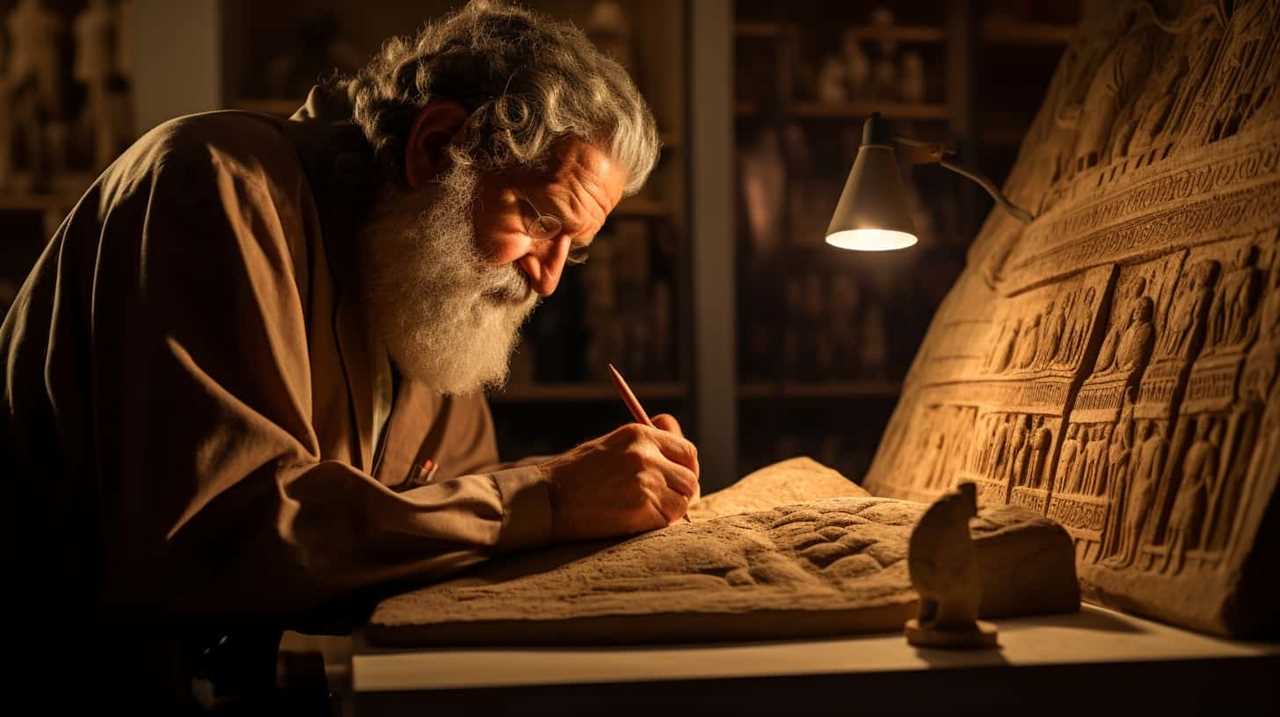What knowledge can be gathered from the writings on Mesopotamian clay tablets?
In our quest for knowledge, we often speculate about the secrets hidden within these ancient artifacts. Mesopotamian clay tablets, dating back thousands of years, have captivated scholars and historians alike.
Through meticulous examination and translation, we have uncovered a wealth of information about the civilization that thrived in the cradle of civilization. These inscriptions provide invaluable insights into the origins of writing systems, the historical events that shaped their society, and even the day-to-day activities of Mesopotamian life.
As we delve into the contents of these clay tablets, we are granted a unique window into the past, allowing us to piece together the puzzle of Mesopotamian society and culture.

Key Takeaways
- Mesopotamian clay tablet inscriptions reveal the origins and development of writing systems in the region, with cuneiform being the most well-known.
- Cuneiform writing played a significant role in the organization of society, the establishment of legal systems, and the preservation of cultural and historical records.
- Clay tablet inscriptions cover a wide range of subjects, including religious rituals, agriculture practices, legal codes, astronomy, and epic tales.
- These inscriptions also provide insights into the beliefs and practices of Mesopotamian civilization, including the depiction of divine beings, the significance of rituals, and the practice of divination.
Origins of Mesopotamian Inscriptions
In exploring the origins of Mesopotamian inscriptions, we find a fascinating use of clay tablets as a means of recording information. The origins of writing can be traced back to around 3200 BCE in Mesopotamia, where the earliest known examples of writing were discovered. These archaeological discoveries have provided invaluable insights into the development of writing systems used in inscriptions.
One of the most significant archaeological discoveries is the Sumerian city of Uruk, where thousands of clay tablets have been excavated. These tablets contain various types of inscriptions, including administrative records, legal documents, and literary texts. The use of clay tablets as a writing medium allowed for the preservation of information over long periods of time. The clay tablets were impressed with wedge-shaped marks made by a stylus, creating a script known as cuneiform.
The origins of writing in Mesopotamia revolutionized human communication and record-keeping. The development of writing systems allowed for the proliferation of knowledge, the establishment of legal systems, and the advancement of civilization. It paved the way for the creation of complex societies and the transmission of ideas across generations.
Transitioning into the subsequent section about ‘writing systems used in inscriptions’, it’s important to understand the significance of cuneiform as the earliest known writing system in Mesopotamia.

Writing Systems Used in Inscriptions
We discovered numerous types of writing systems used in the inscriptions on Mesopotamian clay tablets. These writing systems provide valuable insights into the origins of writing systems and the evolution of cuneiform. Here are five fascinating aspects of the writing systems used in Mesopotamian inscriptions:
- Cuneiform: The most well-known writing system used in Mesopotamia, cuneiform was a wedge-shaped script that evolved from pictographs. It was mainly used to record administrative, economic, and religious information.
- Sumerian Script: The earliest known writing system in Mesopotamia, the Sumerian script was a complex combination of pictographs and wedge-shaped signs. It was used to write the Sumerian language and was later adapted for other languages in the region.
- Akkadian Script: Derived from the Sumerian script, the Akkadian script was used to write the Akkadian language, which became the lingua franca of Mesopotamia. It incorporated both logographic and syllabic elements.
- Elamite Script: The Elamite script was used to write the Elamite language, which was spoken in ancient Elam. It was a syllabic script that had both logographic and phonetic signs.
- Old Persian Script: The Old Persian script was used to write the Old Persian language, which was the official language of the Achaemenid Empire. It was an alphabetic script with 36 characters.
Studying these diverse writing systems provides us with a deeper understanding of the development and cultural interactions of ancient Mesopotamia. Through the evolution of cuneiform and the adoption of various writing systems, we can trace the intellectual and linguistic history of this remarkable civilization.
Significance of Cuneiform Writing
Cuneiform writing sheds light on the importance and impact of ancient Mesopotamian clay tablet inscriptions. This writing system, which originated in Mesopotamia around 3200 BCE, played a significant role in the cultural evolution of the region. It allowed for the recording and dissemination of information, marking a crucial shift from an oral tradition to a written one. The educational value of cuneiform writing can’t be overstated, as it provided a means for the transmission of knowledge across generations.
The significance of cuneiform writing lies not only in its practicality but also in its impact on the development of civilization. The ability to record laws, treaties, administrative documents, religious texts, and literary works on clay tablets revolutionized communication and governance. It facilitated the organization of society, the establishment of legal systems, and the preservation of cultural and historical records. Without cuneiform writing, much of our understanding of ancient Mesopotamia would be lost.

Furthermore, cuneiform writing contributed to the cultural evolution of the region by fostering intellectual growth. The educational value of this writing system allowed for the development of schools and the training of scribes, who became the custodians of knowledge. Through their meticulous transcriptions and translations, they ensured the preservation and dissemination of important texts, contributing to the intellectual and cultural advancements of ancient Mesopotamia.
Subjects Covered in Clay Tablet Inscriptions
Clay tablet inscriptions provide insights into a wide range of subjects through their detailed records and depictions. These ancient artifacts offer a window into the origins of writing and the cultural practices of the Mesopotamian civilization. Here are five fascinating subjects covered in clay tablet inscriptions:
- Economic activities: Clay tablets often contain records of transactions, contracts, and inventories, shedding light on the economic practices of the time. These inscriptions detail trade, taxation, and the distribution of resources.
- Legal codes: Ancient legal systems are revealed through tablets inscribed with laws, judgments, and legal disputes. These inscriptions provide valuable information about the administration of justice and the social structure of Mesopotamian society.
- Mythology and religion: Clay tablets contain stories, prayers, and rituals related to Mesopotamian myths and deities. These inscriptions offer glimpses into the religious beliefs and practices of the civilization.
- Scientific knowledge: Tablets with astronomical and mathematical calculations demonstrate the Mesopotamians’ understanding of the cosmos and their advancements in mathematics. These inscriptions reveal their sophisticated astronomical observations and mathematical techniques.
- Literary works: Epic tales, poems, and literary compositions are preserved on clay tablets. These inscriptions contribute to our understanding of ancient Mesopotamian literature and storytelling traditions.
Through the study of clay tablet inscriptions, we can uncover the rich tapestry of Mesopotamian civilization, gaining valuable insights into their economic, legal, religious, scientific, and cultural practices. These inscriptions serve as a testament to the intellectual achievements and cultural heritage of this ancient civilization.
As we delve into the historical events documented on tablets, we’ll further explore the depth and breadth of knowledge these inscriptions provide.

Historical Events Documented on Tablets
When examining the clay tablet inscriptions of Mesopotamia, we uncover a wealth of historical events that were meticulously documented.
One of the key historical events documented on these tablets is the establishment and maintenance of ancient trade routes. These routes facilitated the exchange of goods and ideas between different regions, contributing to the cultural and economic growth of Mesopotamia.
Additionally, the tablets also reveal royal decrees and laws that were enacted by the rulers of the time, providing valuable insights into the governance and legal systems of ancient Mesopotamia.
Ancient Trade Routes
As we delve into the fascinating world of Mesopotamian clay tablet inscriptions, we uncover a wealth of information about the ancient trade routes that were meticulously documented. These inscriptions provide valuable insights into the intricate network of trade that flourished in ancient Mesopotamia and its impact on the civilizations of the time.

Here are five key findings from the tablets:
- The tablets reveal the existence of extensive trade routes connecting Mesopotamia with distant regions such as Egypt, the Indus Valley, and Anatolia.
- The trade routes facilitated the exchange of goods such as textiles, metals, spices, and luxury items, contributing to the economic prosperity of the ancient civilizations.
- The tablets also document the establishment of commercial centers and trading posts along these routes, demonstrating the organized nature of ancient Mesopotamian trade.
- The inscriptions reveal the use of standardized weights and measures in trade transactions, indicating the development of a sophisticated system of commerce.
- Additionally, the tablets provide evidence of diplomatic and cultural exchanges between different civilizations, fostering a sense of interconnectedness in the ancient world.
Through the study of these clay tablet inscriptions, we gain a deeper understanding of the importance of trade in shaping the ancient Mesopotamian civilizations and their interactions with neighboring regions.
Royal Decrees and Laws
During our exploration of Mesopotamian clay tablet inscriptions, we uncover a wealth of historical events documented in royal decrees and laws. These inscriptions provide valuable insights into the origins of legal systems and the cultural practices of ancient Mesopotamia. The tablets reveal a highly organized society with a complex legal framework that governed various aspects of life, including marriage, property rights, and trade.
One remarkable example is the Code of Hammurabi, a Babylonian law code dating back to the 18th century BCE. This code, inscribed on a black diorite stele, contains 282 laws and offers a glimpse into the justice system and social hierarchy of the time. From these royal decrees and laws, we can understand the importance of maintaining order and stability in ancient Mesopotamian society.

As we delve deeper into the clay tablet inscriptions, we’ll now explore the religious beliefs and rituals revealed.
Religious Beliefs and Rituals Revealed
In examining Mesopotamian clay tablet inscriptions, we gain insight into the religious beliefs and rituals of the ancient civilization.
These inscriptions depict various ancient worship practices, providing evidence of the rituals and ceremonies that were integral to their religious life.
Additionally, the tablets reveal the presence of divine beings, offering a glimpse into the pantheon of gods worshipped by the Mesopotamians.

Through the detailed explanations found on these inscriptions, we can begin to understand the ritual significance and importance of these religious practices in the daily lives of the ancient Mesopotamians.
Ancient Worship Practices
We have discovered that Mesopotamian clay tablet inscriptions reveal fascinating insights into ancient worship practices, shedding light on their religious beliefs and revealing intricate rituals. The worship practices of the Mesopotamians were deeply rooted in their religious beliefs and played a crucial role in their daily lives.
Here are five intriguing aspects of ancient Mesopotamian worship practices:
- Mesopotamian fertility rituals: The Mesopotamians believed in the importance of fertility for the prosperity of their society. Fertility rituals were performed to ensure bountiful harvests and the continuation of life.
- Ancient temple architecture: The temples in Mesopotamia weren’t merely places of worship but also served as political and economic centers. They were grand structures with intricate designs and served as a meeting point between the gods and humans.
- Animal sacrifices: Sacrificing animals was a common practice in Mesopotamian worship. It was believed that offering animals to the gods would please them and ensure their blessings.
- Ritual purification: Before engaging in worship, the Mesopotamians would undergo ritual purification to cleanse themselves spiritually and physically. This included rituals such as washing, anointing with oils, and reciting prayers.
- Divination: The Mesopotamians sought divine guidance through various forms of divination, such as observing the flight of birds, interpreting dreams, or reading the patterns on the liver of sacrificed animals. Divination played a crucial role in decision-making and understanding the will of the gods.
These aspects of ancient Mesopotamian worship practices provide us with a deeper understanding of their religious beliefs and the intricate rituals they performed to seek favor from the gods.

Divine Beings Depicted
One intriguing aspect that the Mesopotamian clay tablet inscriptions reveal is the depiction of divine beings, providing insights into their religious beliefs and the rituals associated with them.
These inscriptions show that the Mesopotamians worshiped a pantheon of gods and goddesses, each with their own unique characteristics and domains of influence. The tablets depict these divine beings in various artistic representations, including human-like figures with elaborate headdresses and symbols of power. These depictions offer a glimpse into the Mesopotamian understanding of their gods and the importance they placed on their worship.
The tablets also describe the rituals and ceremonies that were performed to honor these divine beings, shedding light on the religious practices of the ancient Mesopotamians. Understanding the significance of these rituals is crucial in comprehending the role of religion in their society.
Now, let’s delve into the next section, where the ritual significance will be explained.

Ritual Significance Explained
Continuing our exploration of Mesopotamian clay tablet inscriptions, we gain further insight into their religious beliefs and rituals through the explanation of the ritual significance. These inscriptions provide us with a glimpse into the ritual practices and cultural significance of the ancient Mesopotamians.
Here are five key points that shed light on their religious ceremonies:
- Invocation of deities: The inscriptions reveal the importance of invoking specific gods and goddesses during rituals, highlighting the Mesopotamians’ belief in the divine presence.
- Offerings and sacrifices: The tablets describe the types of offerings and sacrifices made, such as animal sacrifices and libations, emphasizing the significance of these acts in seeking divine favor.
- Purification rituals: The inscriptions detail various purification rituals, highlighting the Mesopotamians’ desire for spiritual cleansing before engaging in religious activities.
- Festivals and ceremonies: The tablets mention the celebration of various festivals and ceremonies, showcasing the role of communal worship and religious gatherings in Mesopotamian society.
- Divination and oracles: The inscriptions reveal the practice of divination and consulting oracles to seek guidance from the gods, underlining the Mesopotamians’ belief in the supernatural and their desire for divine insight.
Through these ritual practices, the Mesopotamians sought to establish a connection with the divine and ensure their well-being both individually and as a society.
Transitioning into the subsequent section about ‘trade and economic activities depicted’, we can see how these religious beliefs and rituals were intertwined with various aspects of their daily lives.

Trade and Economic Activities Depicted
Numerous clay tablet inscriptions from ancient Mesopotamia depict a wide range of trade and economic activities. These inscriptions provide valuable insights into the trade patterns, marketplaces, and exchange systems of the time.
One of the key trade patterns revealed by the clay tablets is the extensive network of long-distance trade that existed in Mesopotamia. The tablets document the trade of various goods, such as textiles, metals, and agricultural products, between different cities and regions. This suggests that Mesopotamians engaged in both domestic and international trade, establishing economic connections with neighboring regions and distant lands.
Marketplaces played a vital role in facilitating trade and economic activities in Mesopotamia. The clay tablets mention the existence of bustling marketplaces where merchants and traders gathered to buy and sell goods. These marketplaces served as hubs for economic transactions, allowing people to exchange goods and negotiate prices. The tablets also provide information about the types of goods available in these marketplaces, including luxury items like precious metals and gemstones.
The clay tablets also shed light on the various exchange systems used in ancient Mesopotamia. They reveal the use of standardized measures and weights for trade, ensuring fairness and accuracy in transactions. Additionally, the tablets mention the practice of credit and debt, with individuals borrowing and lending goods and money.

Legal and Administrative Records Found
When examining the Mesopotamian clay tablet inscriptions, we gain valuable insights into the ancient bureaucracy and governance systems of this civilization.
These legal and administrative records provide us with a detailed understanding of their legal systems, including contracts, court decisions, and administrative procedures.
Through the deciphering of these inscriptions, we can analyze the organization and functioning of their society, shedding light on the complex web of laws and regulations that governed daily life in ancient Mesopotamia.
Ancient Bureaucracy and Governance
Through the study of Mesopotamian clay tablet inscriptions, we gain insights into the intricacies of ancient bureaucracy and governance, with the discovery of legal and administrative records providing valuable evidence. These records reveal a complex government structure and elaborate administrative practices that were integral to the functioning of Mesopotamian society.

The clay tablets provide evidence of:
- The existence of a centralized authority, with rulers and officials responsible for maintaining order and stability.
- The implementation of laws and regulations to govern various aspects of daily life, including trade, agriculture, and family matters.
- The use of written contracts and agreements, indicating a sophisticated legal system.
- The collection and management of taxes and tribute, ensuring the financial stability of the state.
- The recording of administrative tasks, such as the distribution of resources and the organization of labor.
These discoveries shed light on the advanced bureaucratic systems that existed in ancient Mesopotamia, highlighting their efficiency and effectiveness in governing a complex society.
Insights Into Legal Systems
In the study of Mesopotamian clay tablet inscriptions, we uncover valuable insights into the legal systems through the discovery of legal and administrative records. These records provide us with a detailed understanding of the role of women in Mesopotamian society and the methods of punishment used during that time.
One of the most striking findings is the prominent role of women in the legal system. Contrary to popular belief, women in Mesopotamia held significant legal rights and were active participants in legal proceedings. They could own property, engage in business transactions, and even serve as witnesses in court. This challenges the notion that women in ancient societies were universally marginalized and oppressed.

Additionally, the legal records reveal the various punishment methods employed by Mesopotamian authorities. These methods included fines, physical punishments such as flogging or mutilation, and even imprisonment. This evidence sheds light on the severity of punishments and the importance placed on maintaining social order and deterrence.
The insights gained from these legal and administrative records provide a comprehensive understanding of the Mesopotamian legal system and its treatment of women.
Transitioning into the subsequent section about ‘literary works preserved on clay tablets’, we can now delve into the rich literary tradition that also thrived in ancient Mesopotamia.
Literary Works Preserved on Clay Tablets
We discovered a wealth of literary works preserved on clay tablets using compound prepositions. These ancient tablets provide us with invaluable insights into the literature of Mesopotamia, shedding light on the beliefs, stories, and cultural practices of the people who lived thousands of years ago.

Here are five fascinating examples of literary works preserved on clay tablets:
- Epic of Gilgamesh: This epic poem, considered one of the oldest surviving works of literature, tells the story of a legendary king and his quest for immortality.
- Enuma Elish: Also known as the Babylonian Creation Myth, this epic describes the origins of the universe and the rise of the gods.
- Atrahasis: This narrative describes the flood story, which shares similarities with the biblical tale of Noah’s Ark.
- The Descent of Inanna: This myth recounts the journey of the goddess Inanna to the underworld, symbolizing death and rebirth.
- The Instructions of Shuruppak: This wisdom literature provides guidance on how to live a moral and virtuous life.
The origins of clay tablets can be traced back to ancient Sumer, where they were used as a writing medium as early as the late 4th millennium BCE. To preserve these fragile tablets, they were often baked or dried in the sun, ensuring their longevity. Additionally, clay tablets were sometimes stored in libraries or buried in sealed containers to protect them from damage.
Thanks to these preservation methods, we can still delve into the rich literary heritage of the Mesopotamian civilization.
Insights Into Mesopotamian Society and Culture
Continuing our exploration of the literary works preserved on clay tablets, these ancient inscriptions provide us with valuable insights into Mesopotamian society and culture. Through the study of these tablets, we gain a deeper understanding of daily life and the artistic expressions of the people who lived in this region thousands of years ago.

One of the key insights we gain from these clay tablets is the daily life of the Mesopotamians. The tablets contain records of various aspects of their lives, including economic transactions, legal contracts, and administrative matters. These inscriptions give us a glimpse into their social structure, economic activities, and the roles of different members of society. We learn about the importance of agriculture and trade, the division of labor, and the complex networks that existed within their communities.
Additionally, the artistic expressions found on these clay tablets provide us with a window into the cultural and religious beliefs of the Mesopotamians. The tablets often contain hymns, prayers, and myths that shed light on their worldview and the importance they placed on the divine. We can also see their skill in craftsmanship through intricate carvings and detailed depictions of gods, animals, and daily life scenes.
Frequently Asked Questions
How Were the Clay Tablets Used in Mesopotamia?
In ancient Mesopotamia, clay tablets were an integral part of written communication. They were used for various purposes, such as recording legal transactions, documenting religious rituals, and preserving literature. These tablets have been discovered through archaeological excavations, providing valuable insights into ancient writing techniques.
What Materials Were Used to Create the Clay Tablets?
To create Mesopotamian clay tablets, materials such as clay, water, and straw were used. These tablets were manufactured through a process that involved molding the clay, drying it, and then inscribing information onto the surface using a stylus.

How Were the Clay Tablets Preserved Over Time?
Preservation methods for Mesopotamian clay tablets varied, resulting in their survival over time. Archaeological findings reveal that some tablets were baked, while others were stored in sealed containers or buried in clay pots to protect them from moisture and decay.
What Is the Significance of the Different Shapes and Sizes of the Clay Tablets?
The significance of the different shapes and sizes of the clay tablets lies in understanding the cultural context of Mesopotamian clay tablet inscriptions. These variations indicate various purposes, subjects, and levels of importance within the ancient society.
How Were the Inscriptions on the Clay Tablets Deciphered and Translated?
How did we decipher and translate the inscriptions on the clay tablets? Through meticulous linguistic analysis and the use of decipherment techniques, we unraveled the ancient secrets etched in clay, revealing a wealth of knowledge.
Can the How-To Guide Help Understand the Revealed Inscriptions on Mesopotamian Clay Tablets?
The mesopotamian inscriptions unraveling tutorial offers valuable insights into understanding the revealed messages on ancient clay tablets. By following the step-by-step guide, readers can gain a deeper comprehension of the complex language and symbols used in these inscriptions, unlocking the secrets of Mesopotamian civilization.
Conclusion
Well, congratulations! You’ve made it through the ancient world’s equivalent of reading an encyclopedia.

Mesopotamian clay tablet inscriptions have revealed a treasure trove of information about their origins, writing systems, and the fascinating subjects they covered. From documenting historical events to depicting trade and economic activities, these tablets provide a unique window into the past.
They even offer us a glimpse into Mesopotamian society and culture through their legal records and preserved literary works.
So, grab your chisel and get ready to uncover more secrets of the ancient world!
Fritz is a writer whose humor and wit infuse life into words. His creativity, combined with a profound love for the English language, makes him a unique voice at afterQuotes. Fritz’s engagement with books, culture, and social media adds depth to his contributions, making them resonate with our diverse audience.










